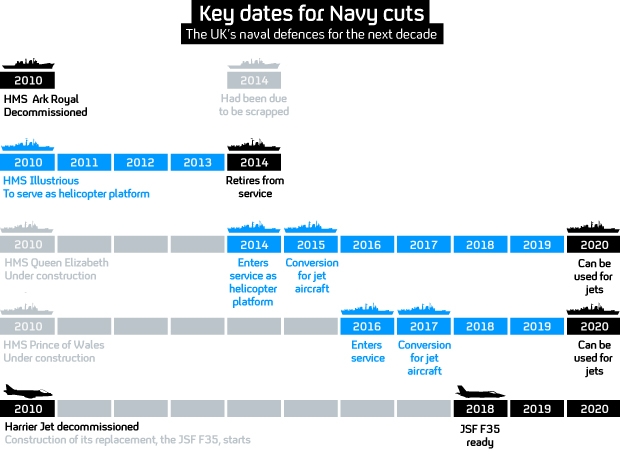Harrier jet’s replacement ten years away
The Harrier jet is to be retired after more than 40 years of service to the RAF and Navy, the government confirmed today in its announcement of defence spending cuts.

The UK will be without a carrier capable of flying jets for around a decade while the Navy’s two new Queen Elizabeth class carriers are built at a cost of £5.9 bn.
It follows the government’s decision to retire its flagship HMS Ark Royal four years early and mothball her fleet of Harrier Jets as part of its Strategic Defence Review.
Although the first of the new carriers – HMS Queen Elizabeth – is set to come into service between 2014 and 2016, converting it to allow it to be used by jets from allied nations could take several years.
Neither HMS Queen Elizabeth nor its sister ship HMS Prince of Wales can be used for British military jets until 2020 and one could yet be mothballed and possibly sold under future options still being looked at by the military.
Armed Forces face 8 per cent cut in Defence review
1998 decisions
In 1998, the Strategic Defence Review announced plans to replace the current Invincible class of aircraft carrier with two larger, more capable vessels that could operate a much more powerful air group.
“Where will the next batch of fixed wing pilots go for the next 10 years?” Rear Admiral Terry Loughran
Rear Admiral Terry Loughran, who was at the helm of Ark Royal from 1993 to 1994 during the Bosnian conflict, said he understood the funding pressures and rationale for scrapping the fleet flagship early.
Loss of skills
But he said the decision to have no flight capability on aircraft carriers for up to 10 years would lead to a massive loss of skills and knowledge.
“It is the scrapping of the Harriers that gives me the greatest concern and highlights that the review is far from strategic,” said Mr Loughran.
“The Harriers were the logical link to the Joint Strike Fighters (JSF) and I have heard Dr Liam Fox say that we have done without them before, but flying from sea is a very perishable skill.
“If we get rid of the Harriers, where in fact will the next batch of fixed wing pilots go for the next 10 years?”
Mr Loughran added that a future decision to mothball or sell one of the new carriers would be robbing the nation of an important strategic asset.
Harrier Facts
The Harrier was the world’s first Vertical Take Off and Landing jet aircraft to enter military service and remains the only craft of its kind.
Its ability to get airborne without a runway made it ideal craft for the Royal Navy’s aircraft carrier, however with a full weapon load the Harrier normally needs a short take-off.
The first Harrier to fly was the XV276 in August 1966. It entered Squadron service in July 1969 with the first aircraft issued to No. 1 Squadron at RAF Wittering.
Developed by the British aircraft maker Hawker Siddeley following World War Two, it features in the arsenals of the UK, the United States, India and Spain.
During the Falklands War, Harriers carried laser guided bombs. Their flexibility has been credited as a major factor in Britain’s 1982 Falklands victory.
In 2006, truck dealer Chris Kelly advertised a Harrier jet that saw action in the Falklands War on Auto Trader.
In 2020, the artist Fiona Banner hung a Harrier in the Tate Britain in a piece questioning the glorification of fighter planes in mainstream British culture.
The Harrier is subsonic but it can reach speeds of approaching 700mph at sea level.
The latest model, the Harrier GR9 aircraft came into service on October 2006.
There are now 36 Harriers based at RAF Cottesmore and Wittering, which are all part of the Joint Force Harrier organisation between the RAF and the Navy.




